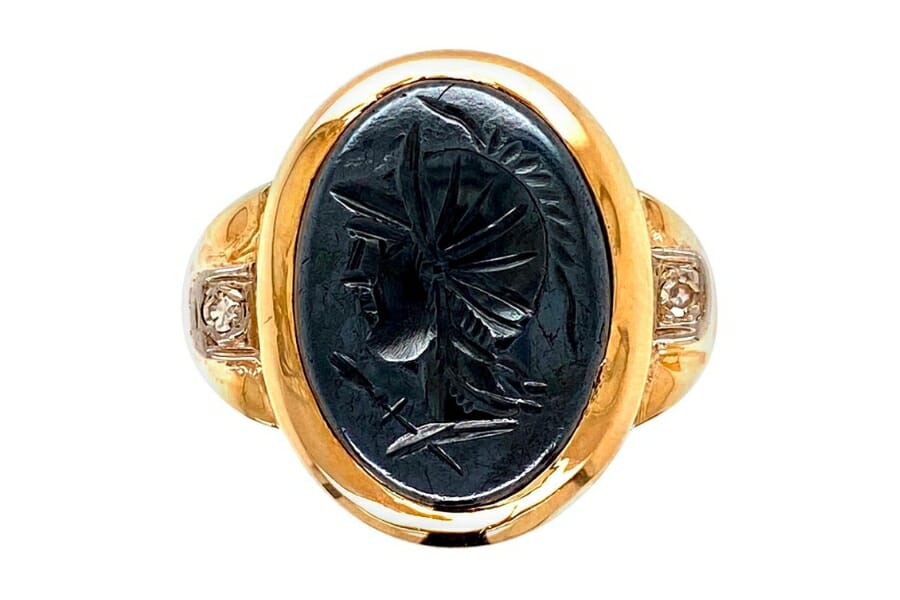Hematite may not be as flashy as a diamond or as colorful as a sapphire, but it’s got a lot going for it. It has been used for thousands of years for everything from jewelry to medicine. It’s a workhorse of a mineral— sturdy, reliable, and unassuming despite its great worth.
But what price should you be paying for Hematite? Well, as it turns out, this unassuming mineral is worth more than you might think. And in this article, we’ll help you dive in a little deeper to discover a Hematite’s true value.
What Hematite Is
Hematite is a mineral that’s primarily composed of iron oxide. Its name comes from the Greek word “haima,” which means blood, due to its reddish-brown color when it’s finely powdered.
Known for its hardness and durability, Hematite has been used for centuries in a range of applications— from pigments and paints to medicinal remedies and spiritual practices. In fact, one of its most distinctive features is its ability to become magnetized, which has led to its use in compasses and other navigation tools. It is also a common mineral found in a range of geological formations, from sedimentary rocks to volcanic formations and even meteorites.
Despite being typically reddish-brown in color, Hematite can also appear gray, black, or silver depending on its form, as follows:
Metallic Hematite
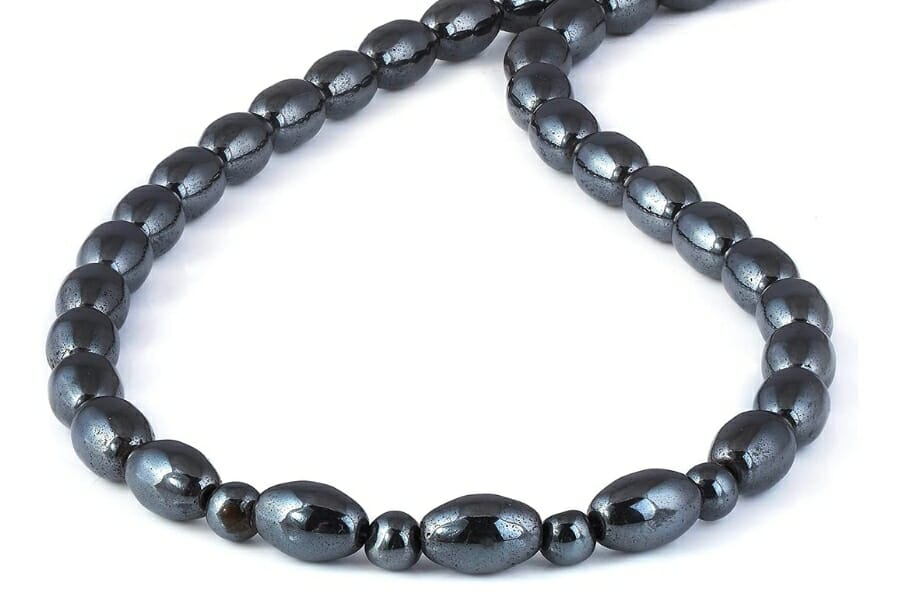
Metallic Hematite is a specific form of this mineral that has a shiny, metallic luster. It’s formed when Hematite is deposited in thin layers, creating a reflective surface that catches the light in a unique way.
Metallic Hematite is a popular choice for jewelry and decorative objects due to its distinctive appearance. It’s often cut and polished into beads or cabochons for use in necklaces, bracelets, and earrings. Its metallic sheen also makes it a great choice for home decor items.
How much is Metallic Hematite worth
Because of its alluring appearance, a carat of Metallic Hematite is worth $0.08 to $3 per carat.
Earthy Hematite
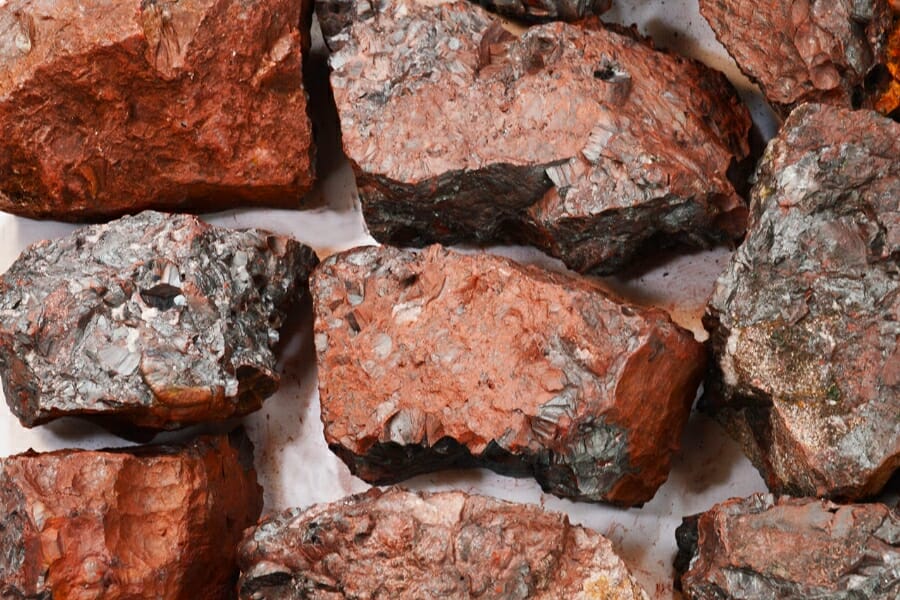
Earthy Hematite is another form that has a more muted, earthy appearance compared to the Metallic form. It’s also known as red Hematite, ocherous Hematite, or Hematite clay. It’s formed when Hematite mixes with other minerals, creating a range of colors from red to brown.
Earthy Hematite is often used for its pigment properties and has been used as a red pigment since ancient times. It’s also used in ceramics and pottery as a glaze colorant. In addition, it’s a popular mineral for decorative objects like bookends and paperweights.
Aside from having different forms, Hematite also come in different varieties that are important to understand in order to have a full grasp of this mineral’s true value.
How much is Earthy Hematite worth
Also sometimes called “raw” Hematite, the earthy type of this mineral costs $0.02 to $0.08 per carat.
Kidney Ore
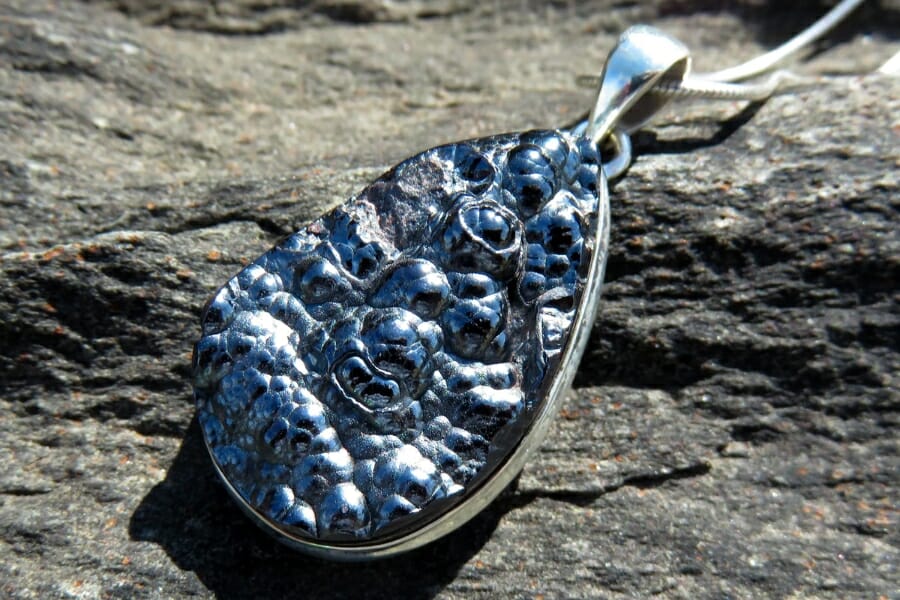
Kidney Ore gets its name from its unique shape, which resembles a kidney. This type of Hematite is formed when Hematite precipitates out of water and accumulates in layers or stalactites, creating rounded or botryoidal shapes.
Kidney ore is typically a deep, dark red color and has a slightly metallic luster. It’s often used for decorative purposes due to its striking appearance and can be found in a variety of sizes, from small specimens for personal collections to large boulders for landscaping or architectural design.
How much is Kidney Ore worth
Kidney Ore tends to sell at $0.04 to $0.5 per carat, which is in the mid-range in contrast with the prices of the other varieties of Hematite.
Martite
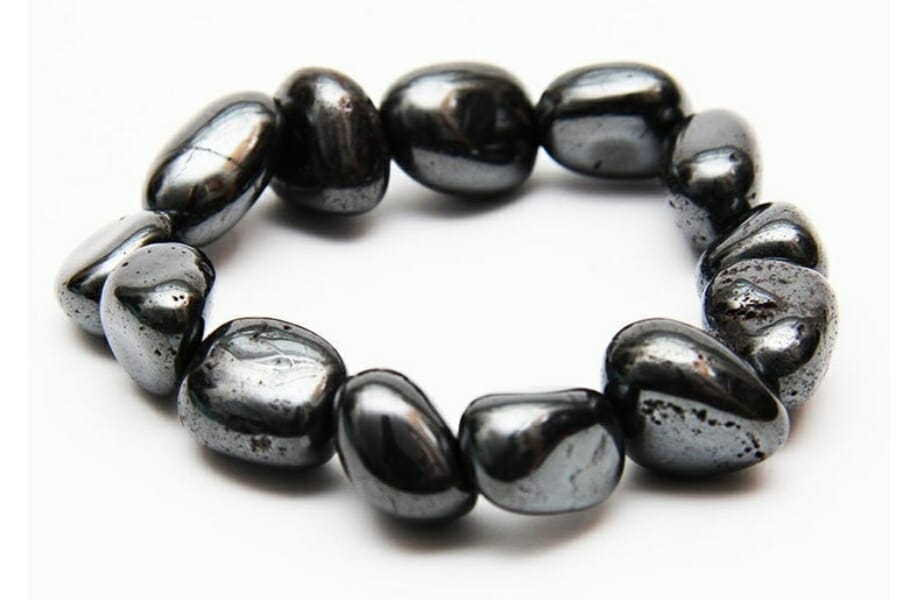
Martite is named after the Spanish mineralogist Sebastian de Marti. This variety is an altered form of Hematite that has undergone a transformation due to high heat and pressure. It’s often found in metamorphic and hydrothermal environments.
Like Kidney Ore, Martite typically has a reddish-brown color and a metallic or dull luster. It’s often found in small, isolated crystals or as coatings on other minerals. It’s not commonly used for decorative purposes due to its small size and lack of distinctive shape, but it’s highly valued by mineral collectors for its rarity and unique formation.
How much is Martite worth
Martite sells at a lower price than Kidney Ore. It’s current market value is at $0.012 to $0.05 per carat.
Iron Rose
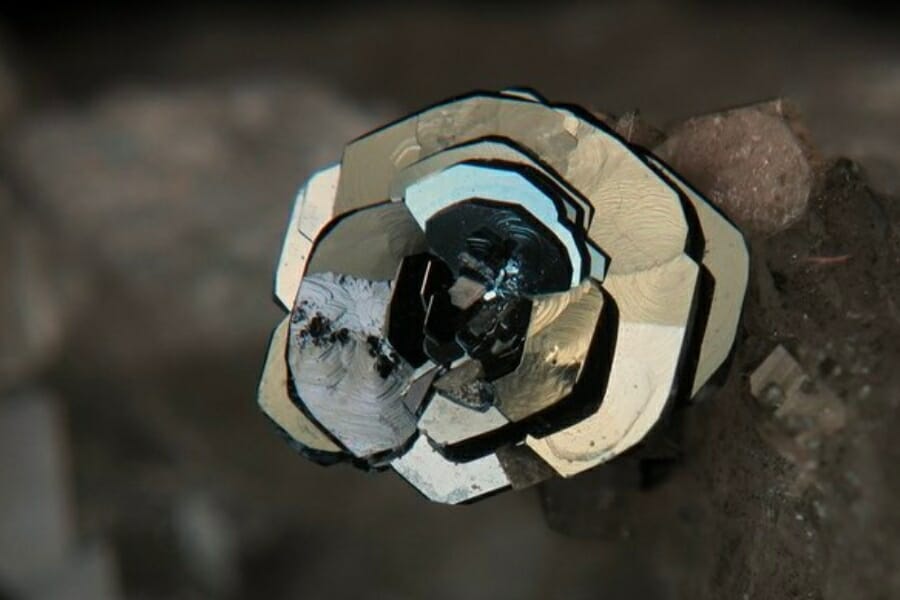
Iron Rose, also known as Hematite “rosettes,” is a unique form that takes on a distinctive shape resembling a rose. It’s formed when Hematite precipitates out of water and accumulates in layers around a nucleus, such as a mineral fragment or fossil.
Typically dark gray or black in color with a metallic luster, Iron Rose can vary in size from small specimens for personal collections to large boulders for landscaping or architectural design. It’s highly valued for its unique and striking appearance and is often used for decorative purposes. Its distinctive rose-like shape is also thought to be associated with the heart chakra, promoting feelings of love and compassion.
How much is Iron Rose worth
Iron Rose is considerably on the more expensive side compared to the other varieties of Hematite at a price of $0.3 to $1 per carat.
Specularite
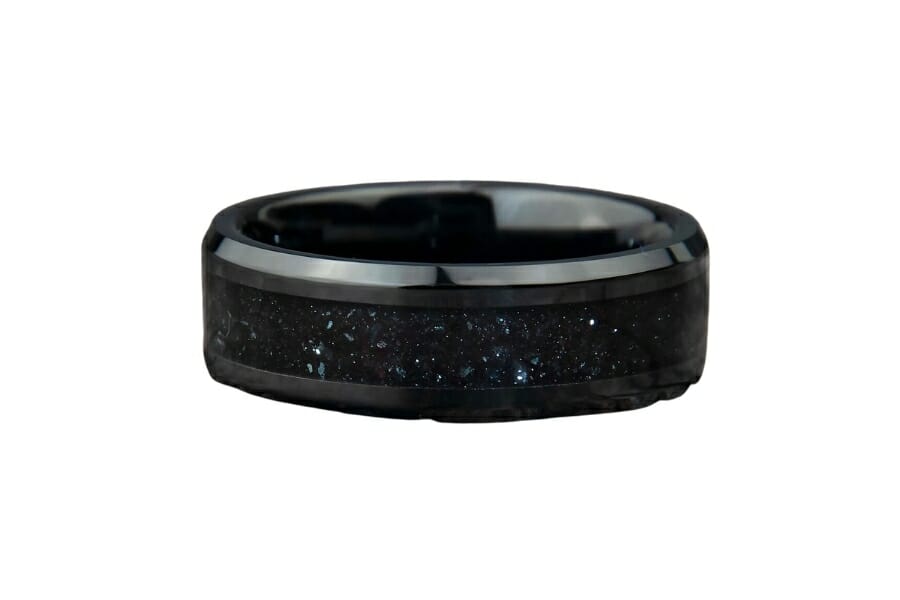
Specularite Hematite, also known as Specular Hematite or Specular Iron, has a metallic luster and a mirror-like appearance. It gets its name from the Latin word “speculum,” meaning mirror, because of its reflective properties.
Specularite is formed when Hematite crystallizes in a flat, tabular form with parallel surfaces, which gives it its characteristic metallic sheen. It’s typically a gray or silver color and is often found in small, flat crystals or as coatings on other minerals. Specularite is highly valued by mineral collectors for its unique appearance and rarity.
Its reflective properties are also believed to be associated with the ability to reflect negativity and promote positive energy.
How much is Specularite worth
This is the most expensive variety of Hematite. It tends to sell at the price of $1 to $5 per carat.
Why Hematite Is So Expensive
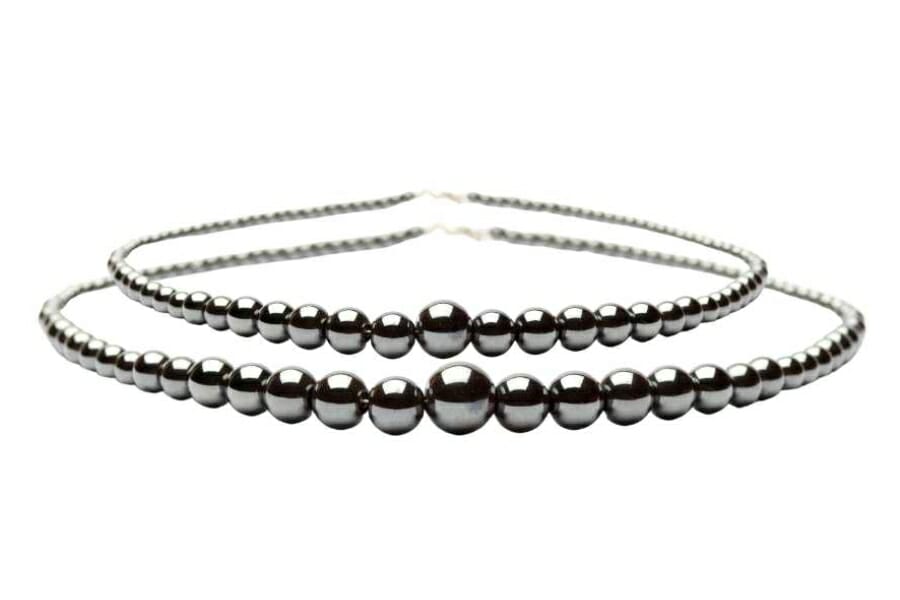
With its striking metallic luster and rich coloration, Hematite is a mineral that has been valued for thousands of years. But what makes it so special, and why is it so expensive?
Hematite is valued for its unique appearance. Its dark, lustrous surface is both eye-catching and mysterious, and it has been used for centuries in jewelry-making, decorative arts, and even architecture. This iron oxide mineral is also known for its durability, making it an ideal material for use in tools, machinery, and other industrial applications.
But Hematite is not just valued for its physical properties— it has long been associated with a range of metaphysical properties and healing benefits, too. Many people believe that Hematite can promote feelings of grounding, stability, and protection, making it a popular choice for spiritual and healing practices. It’s said to help balance and align the root chakra, which is associated with feelings of safety and security.
Hematite is also believed to promote mental clarity and focus, making it a popular choice for meditation and mindfulness practices. Its ability to absorb negative energy and promote positivity has also made it a sought-after mineral for use in feng shui and other spiritual practices.
All of these factors, as well as its relative rarity, contribute to the Hematite’s high value. While it can be found in many parts of the world, high-quality specimens with unique formations and desirable metaphysical properties are much harder to come by. As a result, Hematite can be quite expensive, particularly in the world of mineral collecting and fine jewelry.
How To Determine The Value Of Hematite
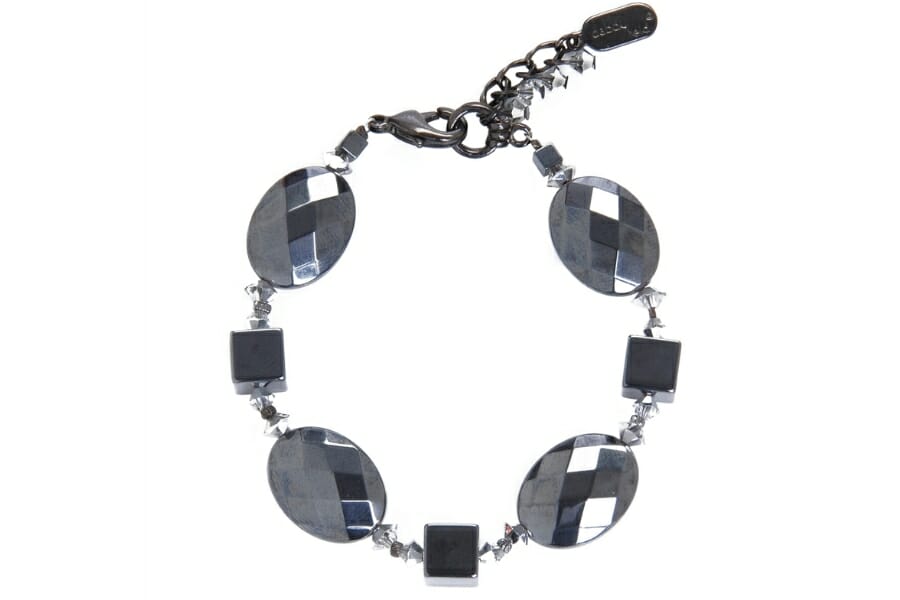
There are several factors that influence and help determine the value of Hematite, that’s why there’s no one price that fits all specimens of this mineral.
Rarity
Hematite is a relatively common mineral, but certain varieties, such as Kidney Ore or Iron Rose Hematite, can be much rarer and more valuable. Additionally, specimens from certain locations, such as the Iron Quadrangle in Brazil or the Lake Superior region in the United States, may be more sought-after and expensive.
Color
The color of Hematite can also vary depending on the specific variety. Sometimes referred to as Bloodstone, this mineral is highly-valued for its deep red coloration, which is caused by the presence of iron oxide.
The different varieties also have specific color-related characteristics that affect Hematite’s price. For example, Specular Hematite, which has a metallic, silvery appearance, is more valuable and expensive compared to other varieties.
Carving and Craftsmanship
Unlike gemstones, Hematite is not typically cut or faceted. Instead, it’s usually sold in its natural form. But the way in which it’s prepared for sale can impact its value. For example, Hematite that have been carefully mounted or presented may be more valuable than those that are sold loose or unmounted.
In some cases, Hematite may be used as a decorative stone and cut into cabochons or other shapes for use in jewelry or other decorative arts. In these cases, the quality of the cut and its overall appearance can impact its value.
Quality
The quality of the Hematite, including its luster, coloration, and formation, can greatly impact its value. High-quality specimens with desirable characteristics are generally more expensive than those with flaws or imperfections.
Size and weight
As with many other minerals and gemstones, the size of a piece of Hematite also impacts its price. Larger specimens are often more valuable, particularly if they are well-formed and display desirable characteristics.
Market
The specific market in which the Hematite is being sold can also influence its price. For example, Hematite specimens sold in the fine mineral collecting market may be more expensive than those sold for industrial use or decorative purposes.
Hematite Price By Form and Variety
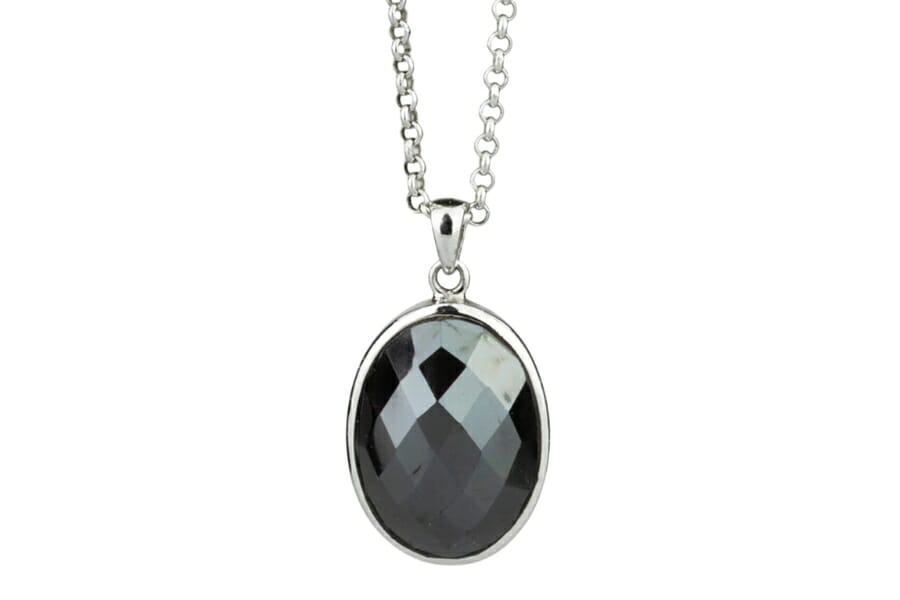
Hematite’s price varies depending on the form and variety it comes in, so to give you a clearer view of just how much this mineral is worth, here’s a table that shows Hematite’s value by form and variety.
Hematite values by form
| Form | Price (Per Carat) |
| Earthy | $0.02 to $0.08 |
| Metallic | $0.08 – $3 |
Hematite values by variety
| Variety | Price (Per Carat) |
| Iron Rose | $0.3 – $1 |
| Kidney Ore | $0.04 – $0.5 |
| Martite | $0.012 – $0.05 |
| Specularite | $1 – $5 |
Now, let’s have a little more fun around Hematite’s value and see what it will cost you depending on different units of measurement.
Hematite pricing by unit of measurement
| Measurement | Price |
| A carat of Hematite | $0.012 to $5 |
| A gram of Hematite | $0.06 to $25 |
| An ounce of Hematite | $1.70 to $709 |
| A kilogram of Hematite | $60 to $25,000 |
| A pound of Hematite | $27 to $11,340 |
| A ton of Hematite | $54,431 to $22,679,625 |
The Most Expensive Hematite
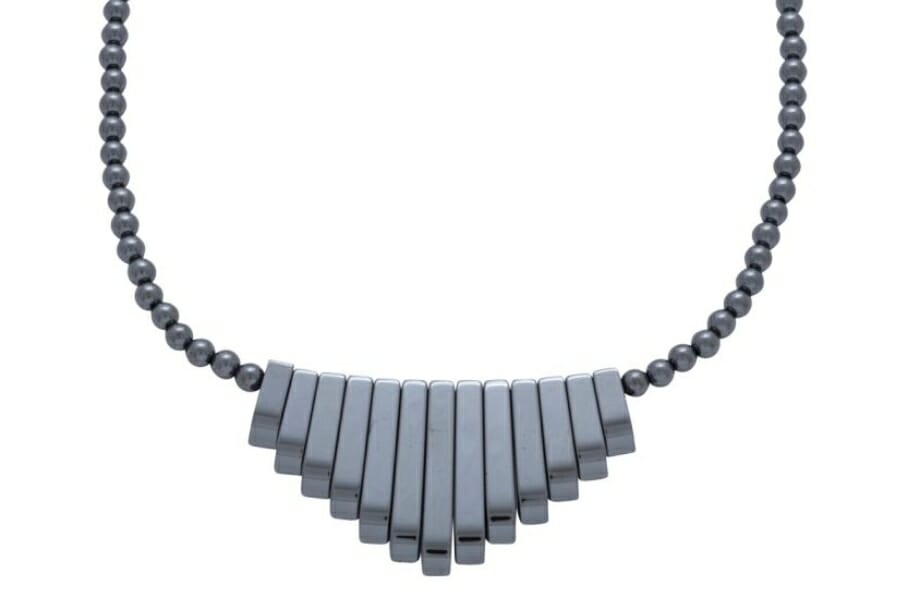
There is no official record of the most expensive Hematite ever sold, but there are some notable specimens that have sold for significant sums in the past.
One example is the “Big Daddy” Hematite, which was discovered in the 1970s in Marquette County, Michigan. The specimen, which weighed in at over 10,000 pounds, featured a large formation of sharp, metallic Hematite crystals. It was acquired by the University of Michigan Mineral Museum in the late 1970s for a reported price of $100,000, making it one of the most valuable Hematite specimens ever sold.
Another notable Hematite is the “Turgite Rose” from Brazil, which is characterized by its intricate, rose-like formations of intergrown Hematite crystals. This specimen was acquired by the Smithsonian Institution’s National Museum of Natural History in 2012 for an undisclosed sum, reportedly in the six-figure range.
How To Get An Appraisal On Your Hematite
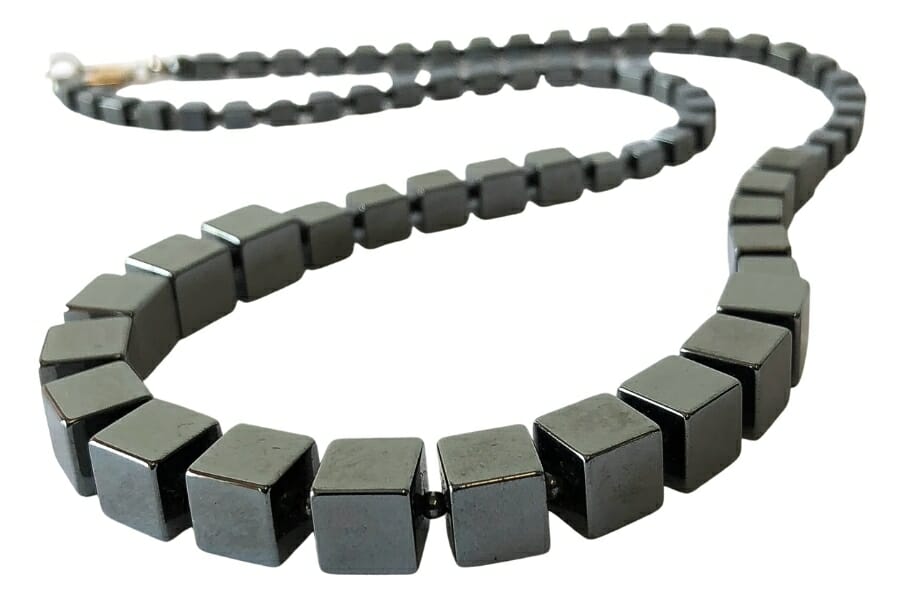
If you’re looking to get an appraisal on your Hematite, there are a few key steps you can take to ensure that you get an accurate and fair valuation.
First, do your research to find a reputable and experienced appraiser who specializes in minerals and gemstones. Look for appraisers who have a strong track record and positive reviews from previous clients. It’s also important to find one who is certified by trusted organizations, such as the Gemological Institute of America.
Once you’ve found an appraiser, provide them with as much information as possible about your Hematite specimen. This may include its size, weight, location of origin, and any unique features or characteristics. You may also want to provide any documentation or certificates of authenticity that you have, as this can help to verify the value of your specimen.
During the appraisal process, be sure to ask any questions you may have and provide any additional information that the appraiser may need. This can help to ensure that the appraisal is as accurate and comprehensive as possible.
Ultimately, the value of your Hematite specimen will depend on a variety of factors, as we’ve discussed above. By working with a reputable and experienced appraiser, you can get a better understanding of the value of your Hematite and make informed decisions about how to best manage and care for your collection.

